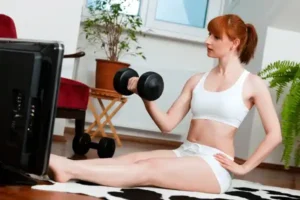Table of Contents
ToggleIntroduction: A Tale of Two Mats
When it comes to floor-based exercises, having a comfortable and supportive mat is essential. However, with numerous available options, it can be unclear to differentiate between an exercise mat and a yoga mat. This comprehensive essay will explore the key differences and similarities between these two mats, shedding light on what makes each unique.
Understanding Exercise Mats vs.Yoga Mat
| Key Feature | Exercise mat | Yoga mat |
| Purpose for | Pilates, stretching routine, bodyweight exercises, high-intensity workouts, etc. | Focused on physical postures (asanas), breath control (pranayama), meditation, |
| Thickness & Padding | 10 mm-20mm | 3mm (1/8 inch) up to 6mm (¼ inch) in thickness |
| Material | Rubber & PVC foam | PVC, natural rubber, or eco-friendly options such as cork or TPE (Thermoplastic Elastomer) |
| Durability & Grip | Excellent for various surfaces | The thinner profile allows yogis to connect more intimately with the ground, enhancing balance and stability during static poses. |
| Reasons for different thickness | The extra thickness helps absorb impact when performing exercises that involve jumping or other vigorous movements. | The thinner profile allows yogis to connect more intimately with the ground, enhancing balance and stability during static poses. |
Now, we explore the above points from various perspectives.
Material: Slick Moves vs. Sticky Situation
Yoga Mats: Where Rubber Meets the Road
Yoga mats are generally made from PVC, rubber, or eco-friendly options like jute. They offer excellent grip. After all, nobody wants to slip into the future while attempting a Warrior III.
Exercise Mats: The Cushion Kings
Generally made of foam or PVC, these mats are designed for comfort rather than grip. They’re the plush hotel bed to a yoga mat’s firm futon.
Brands: When the Mat Hits the Brand
Yoga Mats: Zen Meets Luxury
Lululemon, Manduka, Gaiam—these are the Rolex, Tesla, and Apple yoga mats. These mats come with a price tag as high as your leg in a Standing Hand-to-Big-Toe Pose.
Exercise Mats: Function over Fashion
Brands like Decathlon offer reliable, thick mats without requiring you to mortgage your house. These mats don’t have built-in chakras, but they do the job.
Non-Slip and Other Jargon
Yoga Mats: Stick Around, Pal
The best non-slip yoga mats are crucial for those sweaty Bikram classes. If your mat turns into a Slip ‘N Slide, you’re not the one doing the yoga; you’re the one being done by the yoga!
Exercise Mats: Room to Wiggle
While grip is less essential for exercise mats, if you’re pivoting your feet for a high-energy Zumba session, a thick workout mat with a bit of grip won’t hurt.
Purpose: The Role They Were Born to Play
Yoga Mats: Flexibility is Key
Designed for flexibility and balance, the best yoga mats will have you doing splits in no time (Disclaimer: Time may vary between individuals).
Exercise Mats: Bring on the Burpees
From high-intensity workouts to strength training, these mats are built to absorb impact, making them the best fitness mats for your home gym.
Key Differences: Exercise Mat vs. Yoga Mat
- The primary difference between exercise mats and yoga mats is their intended use. Exercise mats cater to dynamic workouts that involve jumping,.
- impact-based movements,
- And intense cardio exercises.
On the other hand,
- Yoga mats are specifically designed for yoga practice—focusing on stability during static holds, balance postures, and seated meditation.
- Thickness and Cushioning Level
Exercise mats typically have thicker padding compared to yoga mats due to the higher impact nature of fitness activities they support.
In contrast,
Yoga mats offer a thinner profile that allows for better connection with the ground—a crucial element for maintaining proper alignment in various asanas.
Grip Performance
While exercise and yoga mats provide grip features, there are subtle differences.
Exercise mat surfaces often prioritize slip resistance during high-intensity movements. In contrast, some advanced yoga mat designs aim to strike a delicate balance between traction and allowing smooth transitions between poses.
Overlapping Similarities: At a glance
Despite their differences, exercise mats and yoga mats also share common qualities:
– Portability: These fitness accessories are generally lightweight and easy to carry.
– Easy Maintenance: Most exercise & yoga mat materials allow hassle-free cleaning with simple soap-and-water solutions or wipes.
– Versatility: While primarily designed for specific activities, both floor-based essentials can accommodate various exercises beyond their core purpose.
The Thicker, the Better
Is thicker always better? Well, if we’re talking milkshakes or bank accounts, sure. But when it comes to mats, it depends on the activity. Best thick yoga mats offer more cushioning for your joints but can compromise balance. Meanwhile, thick workout mats are like the marshmallows in your hot cocoa—comforting and supportive during high-impact routines. A thick fitness mat is ideal for HIIT or plyometric workouts but might be overkill for a gentle yoga session.
The Decathlon Debate
Many people wonder about the mats from Decathlon, an all-in-one fitness hub that sells everything from socks to kayaks. Their yoga mats, or “yoga mattresses,” are known for being durable and affordable. But here’s the thing: a Decathlon yoga mat might not cut your ultimate HIIT partner. They tend to be tailored more for yoga and may lack the thickness and shock absorbency needed for a punishing Tabata session.
The Brand Game
When considering your mat options, yoga mat brands do make a difference. Premium brands often offer mats that are eco-friendly, longer-lasting, and come with warranties. You get what you pay for; no one ever bragged about their designer mat falling apart after a week.
A Mat for All Reasons
So, are exercise mats and yoga mats the same? In a word, no. An exercise mat is the Swiss Army knife of mats, built for the rough and tumble of various activities. A yoga mat, on the other hand, is like a finely-tuned violin—crafted for a specific type of performance. The best training mat for you will depend on your primary form of exercise.
Choosing Your Perfect Mat Match/Verdict
When deciding between an exercise mat or a yoga mat, consider the primary activities you’ll engage in and the specific features that align with your needs.
An exercise mat’s thicker padding and durability make it an excellent choice for dynamic workouts, while a yoga mat’s thinner profile enhances stability during static poses. Ultimately, If you plan to focus primarily on yoga practice but occasionally incorporate other exercises,
A versatile yoga mat may suffice.






